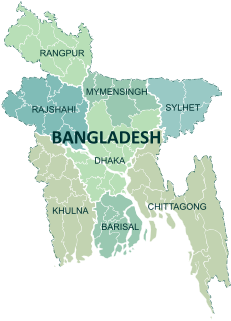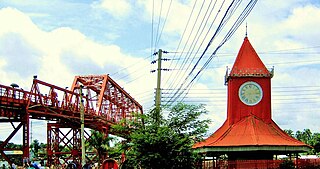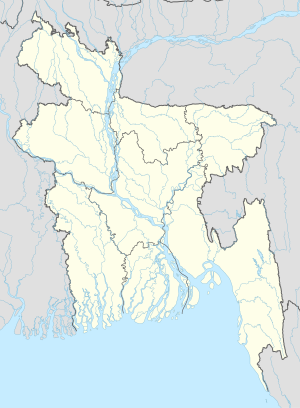
Bangladesh, officially the People's Republic of Bangladesh, is a country in South Asia. It is the eighth-most populous country in the world, with a population exceeding 165 million people in an area of 148,460 square kilometres (57,320 sq mi). Bangladesh is among the most densely populated countries in the world, and shares land borders with India to the west, north, and east, and Myanmar to the southeast; to the south it has a coastline along the Bay of Bengal. It is narrowly separated from Bhutan and Nepal by the Siliguri Corridor; and from China by the Indian state of Sikkim in the north. Dhaka, the capital and largest city, is the nation's political, financial and cultural center. Chittagong, the second-largest city, is the busiest port on the Bay of Bengal. The official language is Bengali, one of the easternmost branches of the Indo-European language family.

Bengal is a geopolitical, cultural and historical region in South Asia, specifically in the eastern part of the Indian subcontinent at the apex of the Bay of Bengal, predominantly covering present-day Bangladesh and the Indian state of West Bengal. Geographically, it consists of the Ganges-Brahmaputra delta system, the largest river delta in the world and a section of the Himalayas up to Nepal and Bhutan. Dense woodlands, including hilly rainforests, cover Bengal's northern and eastern areas, while an elevated forested plateau covers its central area; the highest point 3,636 metres (11,929 ft) is at Sandakphu. In the littoral southwest are the Sundarbans, the world's largest mangrove forest. The region has a monsoon climate, which the Bengali calendar divides into six seasons.

Dhaka, formerly known as Dacca, is the capital and largest city of Bangladesh, as well as the world's largest Bengali-speaking city. It is the eighth largest and sixth most densely populated city in the world with a population of 8.9 million residents as of 2011, and a population of over 21.7 million residents in the Greater Dhaka Area. According to a Demographia survey, Dhaka has the most densely populated built-up urban area in the world, and is popularly described as such in the news media. Dhaka is one of the major cities of South Asia and a major global Muslim-majority city. Dhaka ranks 39th in the world and 3rd in South Asia in terms of urban GDP. As part of the Bengal delta, the city is bounded by the Buriganga River, Turag River, Dhaleshwari River and Shitalakshya River.

The economy of Bangladesh is characterised as a developing market economy. It is the 35th largest in the world in nominal terms or at current prices, and 25th largest by purchasing power parity; international dollars at current prices. It is classified among the Next Eleven emerging market middle income economies and a frontier market. In the first quarter of 2019, Bangladesh's was the world's seventh fastest-growing economy with a real GDP or GDP at constant prices annual growth rate of 8.3%. Dhaka and Chattogram are the principal financial centres of the country, being home to the Dhaka Stock Exchange and the Chattogram Stock Exchange. The financial sector of Bangladesh is the second largest in the Indian subcontinent. Bangladesh is one of the fastest growing economies in the world and South Asia.

Divisions are the first-level administrative divisions in Bangladesh. As of 2022, there are eight divisions of Bangladesh, each named after the major city within its jurisdiction that also serves as the administrative seat of that division. Each division is divided into several districts which are further subdivided into upazilas, then union councils.

Sheikh Mujibur Rahman, often shortened as Sheikh Mujib or Mujib and widely known as Bangabandhu was a Bangladeshi politician, statesman and Founding Father of Bangladesh who served as the first President and later as the Prime Minister of Bangladesh from April 1971 until his assassination in August 1975. Mujib is credited with leading the successful campaign for Bangladesh's independence from Pakistan. He is revered in Bangladesh with the honourific title of "Bangabandhu" which is used around the world. He was a founding member and eventual leader of the Awami League, founded in 1949 as an East Pakistan–based political party in Pakistan. Mujib is considered to have been a fundamental figure in the efforts to gain political autonomy for East Pakistan and later as the central figure behind the Bangladesh Liberation Movement and the Bangladesh Liberation War in 1971. Thus, he is regarded as the "Jatir Janak" or "Jatir Pita" of Bangladesh. His daughter Sheikh Hasina is the current leader of the Awami League and currently serves as the Prime Minister of Bangladesh.

Chittagong, officially Chattogram, is the second-largest city in Bangladesh after Dhaka. It is the administrative seat of the eponymous division and district. It hosts the busiest seaport on the Bay of Bengal. The city is located on the banks of the Karnaphuli River between the Chittagong Hill Tracts and the Bay of Bengal. The Greater Chittagong Area had a population of more than 5.2 million in 2022. In 2020, the city area had a population of more than 3.9 million.

The Bangladesh Awami League, often simply called the Awami League or AL, is a centrist to centre-left political party in Bangladesh and one of the major political parties in Bangladesh, being the ruling party of Bangladesh since 2009. It previously was a political Party in the Pakistani province of East Pakistan which later seceded after Bangladesh Liberation War to form Bangladesh.

Sylhet is a metropolitan city in northeastern Bangladesh. It is the administrative seat of the Sylhet Division. Located on the north bank of the Surma River at the eastern tip of Bengal, Sylhet has a subtropical climate and lush highland terrain. The city has a population of more than half a million and is one of the largest cities in Bangladesh after Dhaka, Chittagong and Khulna. Sylhet is one of Bangladesh's most important spiritual and cultural centres. Furthermore, it is one of the most economically important cities after Dhaka and Chittagong. The city produces the highest amount of tea and natural gas.

Sheikh Hasina Wazed is a Bangladeshi politician and stateswoman who has served as the Prime Minister of Bangladesh since January 2009. Hasina is the daughter of the founding father and first President of Bangladesh, Bangabandhu Sheikh Mujibur Rahman. She previously served as prime minister from June 1996 to July 2001. She is the longest serving prime minister in the history of Bangladesh, having served for a combined total of over 18 years. As of 13 October 2022, she is the world's longest-serving female Head of Government in history.

The Bangladesh Liberation War, also known as the Bangladesh War of Independence, or simply the Liberation War in Bangladesh, was a revolution and armed conflict sparked by the rise of the Bengali nationalist and self-determination movement in erstwhile East Pakistan which resulted in the independence of Bangladesh. The war began when the Pakistani military junta based in West Pakistan under the orders of Yahya Khan launched Operation Searchlight against the people of East Pakistan on the night of 25 March 1971, initiating the Bangladesh genocide. It pursued the systematic annihilation of nationalist Bengali civilians, students, intelligentsia, religious minorities and armed personnel. The junta annulled the results of the 1970 elections and arrested Prime minister-designate Sheikh Mujibur Rahman. The war ended on 16 December 1971 when the military forces of West Pakistan that were in Bangladesh surrendered in what remains to date the largest surrender of armed personnel since the Second World War.

The Bangladesh men's national cricket team, popularly known as The Tigers, is administered by the Bangladesh Cricket Board (BCB). It is a Full Member of the International Cricket Council (ICC) with Test, One-Day International (ODI) and T20 International (T20I) status. It played its first Test match in November 2000 against India with a 9 wicket loss in Dhaka, becoming the tenth Test-playing nation.

The Bangladesh national football team is the national recognised football team of Bangladesh and is controlled by the Bangladesh Football Federation (BFF). It is a member of the Asian Football Confederation, and became a member of FIFA in 1974. Even though the Bangladesh Football Federation was first founded in 1972. Bangladesh was elected as a member of the AFC Executive Committee in 1982–1986 and 1998–2002. The current Executive Committee was elected democratically, under an AFC approved constitution and direct supervision of FIFA & AFC, in October 2020.

The Bangladesh Navy is the naval warfare branch of the Bangladesh Armed Forces, responsible for Bangladesh's 118,813 square kilometres (45,874 sq mi) of maritime territorial area, and the defence of important harbours, military bases and economic zones. The primary role of the Bangladesh Navy is to protect the country's economic and military interests at home and abroad. The Bangladesh navy is also a front line disaster management force in Bangladesh, and participates in humanitarian missions abroad. It is a key regional player in counter terrorism efforts, and engages in global peacekeeping with the United Nations.

The Bangladesh Army is the land warfare branch and the largest component of the Bangladesh Armed Forces. The primary mission of the Army is to provide necessary forces and capabilities to deliver the Bangladeshi government's security and defence strategies and defending the nation's territorial integrity against external attack. Control of personnel and operations is administered by the Army Headquarters, Dhaka. The Bangladesh Army is also constitutionally obligated to assist the government and its civilian agencies during times of domestic national emergency. This additional role is commonly referred to as "aid to civil administration".

Bengalis, also rendered as Bangalee or the Bengali people, are an Indo-Aryan ethnolinguistic group originating from and culturally affiliated with the Bengal region of South Asia. The current population is divided between the independent country Bangladesh and the Indian states of West Bengal, Tripura and parts of Assam, Meghalaya and Manipur. Most of them speak Bengali, a language from the Indo-Aryan language family.

Bengali, generally known by its endonym Bangla, is an Indo-Aryan language native to the Bengal region of South Asia. It is the official, national, and most widely spoken language of Bangladesh and the second most widely spoken of the 22 scheduled languages of India. With approximately 300 million native speakers and another 37 million as second language speakers, Bengali is the fifth most-spoken native language and the seventh most spoken language by total number of speakers in the world. Bengali is the fifth most spoken Indo-European language.

Bangladeshis are the citizens of Bangladesh, a South Asian country centered on the transnational historical region of Bengal along the eponymous bay.

The divisions of Bangladesh are divided into 64 districts or zila. The headquarters of a district is called a district seat. The districts are further subdivided into 492 sub-districts or upazila.

















